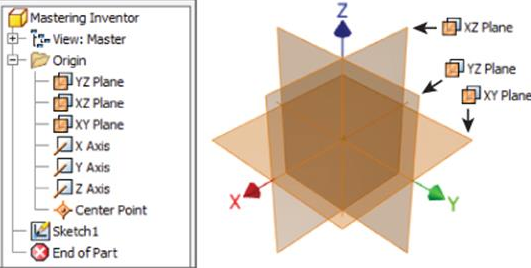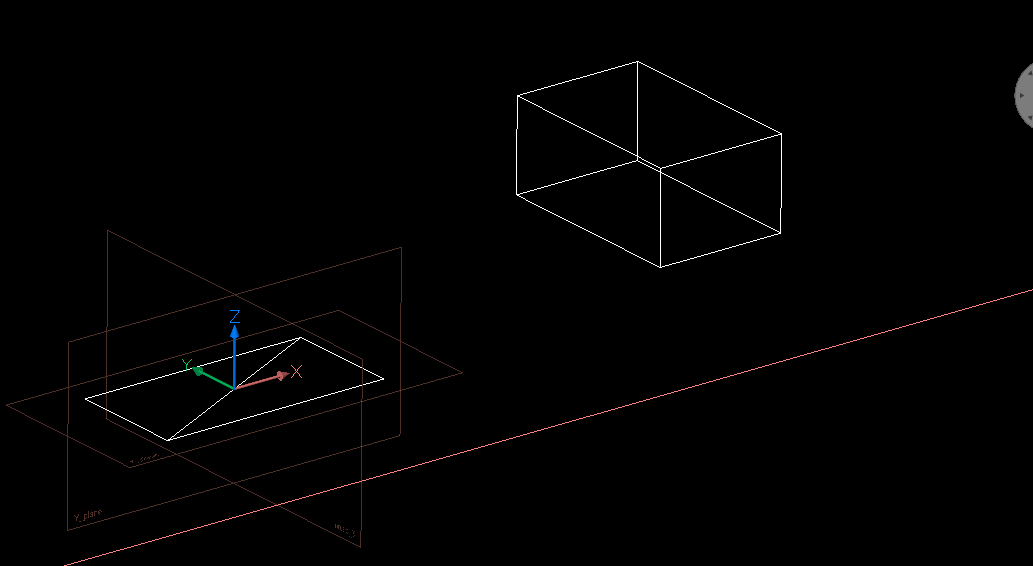Default origin planes - Wish list
Hi search didn't return nothing so here it goes.
Bricscad support can add this to the wish list as a very needed detail.
I'm a "mechanical" user in most case scenarios, so constantly struggling with the lack of "origin planes" as a mech. default option.
Modified my template to add some crud planes, but the functionality is far from what's desirable.
Looking for something like Inventor planes, axis...
Ex. Trying to constraint the middle of a certain component to the middle of another.
Is far from being an expedited process.
PLEASE make it happen. ![]()

Comments
-
You can already display the UCS icon at the origin, and display a grid. Why isn't that enough?
0 -
Hi Roy
Not even close. ;-)
UCS is already at origin and grid comes on / off according to the needs. No worries in that.
Origin planes is the "bread & butter" of almost all MCAD's. I mentioned Inventor, could have said NX, Solidworks, SolidEdge...Below is a basic crud example. From my template, planes are solids, with their own layer, transparency, fixed point in space (0,0,0), etc.
This propagated along several files (components) although works. Is nevertheless a big mess with limited functionality. 0
0 -
You have not answered the question. Why do you ask for this? The UCS and the grid already give sufficient visual feedback IMO.
0 -
From the first post
Ex. Trying to constraint the middle of a certain component to the middle of another.0 -
I don't understand what you mean by the middle points of components (center of gravity?) and how the planes of the coordinate system play a role in constraining them.
0 -
Hi Roy sorry for late reply, only saw it now.
For a better understanding of the capabilities involved and respective use,
please have a look at some other "traditional" MCAD workflow.
It will come quite clear how powerful it can be. Either in sketch, model, assembly, etc.BTW Inventor is my preferred base, mostly and essentially because I have access to it.
So end up being the workhorse for comparison.
Cheers0 -
Hi!
Know it is an old thread, but I think it is still relevant.
I have been working with Solidworks and Inventor for the past 14 years.
it have always been best practice to constraint to origin planes for proformance and for reducing constraints. It has nothing to do with "sufficient visual feedback". If you are working with large+ assemblies, it makes really sence.0 -
@jmaansson
In BricsCAD it is already possible to use the origin, main axes and default planes in constraints. That seems to be a large part of the wish as I understand it. For the rest I get the idea that the wish is based on a workflow with programs that use parametric sketches to drive 3D modeling, which is not possible in BricsCAD.0 -
Ok.
I am testing BricsCAD mechanical for our company to see if we should go from Inventor to BricsCAD. It is working really well for our Autocad users, but for our Inventor users it is really a huge step down if we can't use parametric sketches. It is the essence when working in 3D where you change the dimensions on the skecth all the time.
Normally in Inventor, Soldidworks ect. the 2D constrains are added automatically and therefore a lot faster than adding them manually.If you don't use parametric sketches in Autocad, you don't know what you a missing, and therefore it is not a problem :-D
Is it just me that have these thoughts?..
Sorry for my English... :-D
0 -
I have never worked with Inventor or Solidworks so cannot comment on these programs. But fully parametric models are possible in BricsCAD, it is just that the workflow is different. In BricsCAD you first create the 3D model using for example the direct modeling commands. And then you apply 3D constraints.
This topic may be of interest:
https://forum.bricsys.com/discussion/34618/parametric-model-with-holes0 -
... In V19 there is a new command _Parametrize which can automatically add 3D constraints. I am using V18 and have never used it, but the results I have seen raise some doubts regarding its usefulness.
0 -
Also have a look at the Design Intent Recognition settings. See https://help.bricsys.com/hc/en-us/articles/360006548434-Design-intent-recognition
0 -
Ok! thank you! I will test it tommorow!
0 -
We are a Solidworks shop and have been for 20 years. Every few years or so we review other products to see if anything is at least equivalent and is a better value. We are looking for a Linux solution.. Evaluating BricsCAD Mechanical 19, it looks like it was designed by a AutoCAD user. I loathe AutoCAD, its interface, etc. thus this product already has a major strike against it.
The OP is still very relevant. Anyone who seriously designs MACHINES (not buildings, land plots, etc.) from scratch knows why a coordinate system with view-able/usable planes is necessary. This product doesn't seem to have a coordinate system that is usable to design parts and assemblies.
Guess we'll just need to re-evaluate in a few years to see if BricsCAD Mechanical will have matured a bit more. My recommendation would be to include real-world, experienced MECHANICAL ENGINEERS (not academia) on your design team. But for now, BricsCAD Mechanical is no where near the level of Solidworks.
0 -
@Van said:
We are a Solidworks shop and have been for 20 years. Every few years or so we review other products to see if anything is at least equivalent and is a better value. We are looking for a Linux solution.. Evaluating BricsCAD Mechanical 19, it looks like it was designed by a AutoCAD user. I loathe AutoCAD, its interface, etc. thus this product already has a major strike against it.The OP is still very relevant. Anyone who seriously designs MACHINES (not buildings, land plots, etc.) from scratch knows why a coordinate system with view-able/usable planes is necessary. This product doesn't seem to have a coordinate system that is usable to design parts and assemblies.
Guess we'll just need to re-evaluate in a few years to see if BricsCAD Mechanical will have matured a bit more. My recommendation would be to include real-world, experienced MECHANICAL ENGINEERS (not academia) on your design team. But for now, BricsCAD Mechanical is no where near the level of Solidworks.
BricsCAD does have UCS, the shortcoming the OP identified is that they aren't readily visualised. It can help to make sure that you have the UCSICON, as this provides a visual reference.
When you are assembling components you can reference the components UCS when placing 3D constraints. For example DMCOINCIDENT3D includes options to constrain against the World UCS and block (component) UCS.
Solidworks, Inventor, Creo, or other users coming from a history based modelling background may find it a more difficult leap. BricsCAD is a variational direct modeller, as such it requires a different approach.
Regards,
Jason Bourhill
BricsCAD V19 Ultimate
Quickly create HELP links on your forum posts0


